The Fate of an Infamous Informer
Published in 18th–19th - Century History, Features, Issue 2 (Summer 2001), Volume 9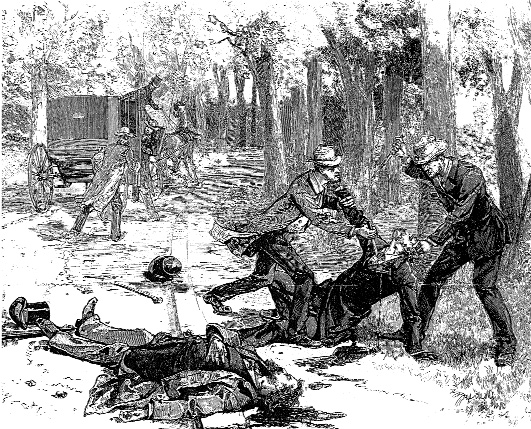
The murders of chief secretary Cavendish and under-secretary Burke in Dublin’s Pheonix Park. (Le Monde, May 1882)
When the body of James Power wasbrought ashore at Port Elizabeth in the Cape Colony on 30 July 1883 thetown became the focus of world attention as never before or since; forJames Power turned out to be James Carey, the notorious assassin—turnedinformer—who had dominated the news since the beginning of the year.
Carey hit the headlines when he was arrested in a round-up of suspectsfor the gruesome murder of Lord Frederick Cavendish, the chiefsecretary for Ireland, and Mr Thomas Henry Burke, the permanentunder-secretary, as they were walking home to their official residencesin the Phoenix Park in Dublin on a fine May evening in 1882. ThePhoenix Park murders created the same sort of sensation as theassassination of President Kennedy did in 1963; according to Tim Healyit was a common saying that no-one forgot where he stood when he heardthe news.
Responsibility was claimed by a hitherto unheard-ofgroup, the Irish National Invincibles. But Superintendent Mallon of theG (detective) division of the Dublin Metropolitan Police had a prettyshrewd idea of who was involved. He suspected a number of former Fenianactivists, recruited and directed from abroad by leading figures in theLand League. By playing off one suspect against another Mallon gotseveral of them to reveal what they knew but his real breakthrough camewhen James Carey turned informer.
The informer’s background
Careywas a Dublin man, the son of a bricklayer, and a bricklayer himself foreighteen years before settling himself up as a master builder. He alsoacquired some slum property which he let out by the room to poortenants. He was an upwardly mobile type, active in an association forpromoting Irish manufactured goods, an office holder in a religiousconfraternity and a regular communicant in the Catholic church. Shortlybefore his arrest he was elected to Dublin corporation. Mallon said hewas the only one among the conspirators capable of addressing ameeting. He appreciated the importance of appearances too; he smokedcigars and wore kid gloves on the journeys from prison to thecourthouse. Politically he had an impeccable revolutionary record; hehad been a member of the Fenians since the early sixties and had takenpart in the 1867 rising. He was thus a cut above the otherconspirators—artisans, labourers, cab drivers and publicans—and forthat reason his apostasy was all the more shocking to his associates.As a result of his evidence five of his companions were hanged,including Dan Curley, godfather of Carey’s two-month-old child, andeight others were sentenced to penal servitude.
Passage to a safe haven
Althoughthe Phoenix Park murders were widely condemned, even in orthodox Feniancircles, there was nothing but anger and revulsion in nationalistIreland against Carey for what he had done. The authorities had no usefor him either but it was incumbent on them to make some provision forhis safety by getting him out of Ireland. The problem was to find asafe haven in the English-speaking parts of the world; the USA andCanada, the Australian colonies and New Zealand, even the Cape Colonyhad too many Fenian sympathisers in them for safety. So Natal waschosen, where the Irish were thin on the ground.
Carey’s wifeand seven children were put into lodgings in the East End of London andCarey was kept in Kilmainham gaol till arrangements had been completed.Then Mrs Carey and five of the children were put aboard the KinfaunsCastle in London as steerage passengers and Carey and the two eldestchildren joined the ship at Dartmouth, all of them travelling as afamily under the name of Power, Mrs Carey’s maiden name, bound for CapeTown on the first stage of their journey.
Travelling on the sameship, with second class berths, was another Irishman called PatrickO’Donnell, a man in his mid–forties, illiterate but respectable both inappearance and conduct, accompanied by a young woman variouslydescribed as his wife or niece. He and the so–called Power became veryfriendly on the voyage; they played dice and draughts and dranktogether. O’Donnell professed to be fond of the children and his ‘wife’took a great fancy to one of the Carey girls who called her ‘auntie’.O’Donnell was booked to Cape Town but so well did he get on with Powerthat he decided to go on with him to Natal and changed his bookingbefore they reached Cape Town. At Cape Town they all transferred to acoastal steamer, the Melrose; they also had time to go ashore; the menwent drinking and on one occasion the two families set off together forthe theatre but found that it was closed.
Assassination
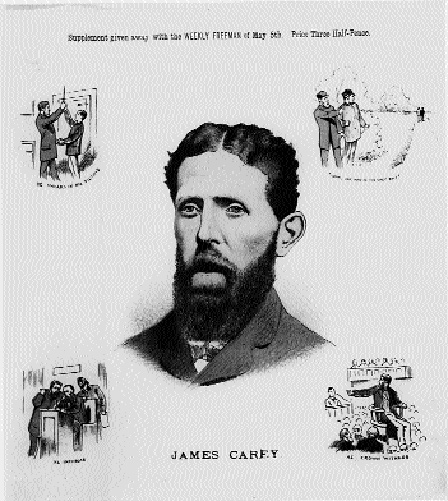
James Carey, with insets depicting the swearing in of members, the identifying of under-secretary Burke, informing, acting as crown witness. (Weekly Freeman, 5 May 1883)
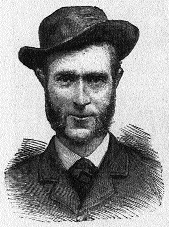
Patrick O’Donnell. (Graphic, 1 September 1883)
TheMelrose sailed on Saturday 28 July. About a quarter to four on Sundayafternoon when O’Donnell and Power were having a drink together in thesaloon O’Donnell drew a revolver and shot his friend three times. Itwas a harrowing scene. The first shot hit Carey in the neck. As hestaggered across the saloon towards the cabin where his wife had justgone O’Donnell shot him again in the back. Mrs Carey came out of thecabin and Carey fell into her arms saying ‘Oh Maggie, I’m shot;O’Donnell has shot me’. Then O’Donnell fired a third shot and Carey andhis wife fell to the floor. Mrs Carey was covered in blood and so toowere the children who ‘all gathered round their father, calling hisname and stamping about being unable to give vent to tears’.
O’Donnell meantime remained sitting on the settee, his wife clinging tohim. Witnesses agreed that though he was not drunk he was under theinfluence of drink and seemed quite bewildered. A bizarre episodeoccurred when O’Donnell approached Mrs Carey and offered to shakehands, saying something that was differently reported by every witness,the most convincing version being ‘I had to do it’. O’Donnell offeredno resistance when he was arrested and put in chains; he told hiscaptors not to be afraid, he was not going to hurt anybody. When hisluggage was searched another revolver, with a box of cartridges wasfound, and a mysterious box, 9–by–9–by–7 inches, which appeared to bean electrical machine. Fearing it was some sort of dangerous device thecaptain had it thrown overboard. It emerged subsequently that it was abattery for treating O’Donnell’s partially paralysed hand. O’Donnelland his victim were taken ashore at Port Elizabeth, O’Donnell to bebrought before the magistrate and Carey to be buried at the North Endgraveyard in Port Elizabeth.
During the proceedings at PortElizabeth there occurred the one instance of humane conduct that hascome to light in this whole affair. Dr Frederick Ensor, the districtsurgeon at Port Elizabeth, conducted the post mortem on Carey and gavehis evidence in the magistrate’s court on the first day of the inquiry.At five o’clock that evening he went to see the prisoner. He askedO’Donnell if he had any relative with him and on being told about theniece he undertook to ask the local Catholic clergy to see to herwelfare. O’Donnell replied, ‘with much emotion’, ‘Then that is all Icare for’. When he found that O’Donnell had been given only bread andwater since his arrest he gave orders that he should be provided withproper food. Later when he learnt that O’Donnell had paced about hiscell all night he prescribed a sleeping draught for him. Dr Ensor alsoattended Carey’s funeral. Finding that neither the Catholic clergy norany other clergyman in the town was prepared to conduct a burialservice he said he thought it only right that a few words should besaid over the grave of ‘this poor man’ and that he would say a prayerto alleviate the distress of Carey’s wife and family.
Popular jubilation…
Sodramatic a sequel to the previous sensation could not fail to excite awidespread and fascinated response. From even as far away as Peking wefind the Portadown man Sir Robert Hart, inspector general of Chinesecustoms, writing: ‘Our latest telegram here says Carey shot dead inP.E. The scoundrel, he deserved it, although a certain amount ofjudicial gratitude is due to him for bringing those other ruffians tothe scaffold’. In London the news of the murder was received with‘exhaltation among the lower classes’. In nationalist Ireland there wasjubilation. Bonfires and effigies of the informer were burned in manyplaces.
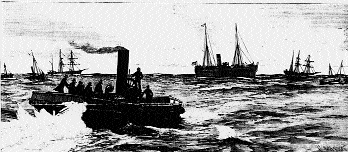
Police launch on way to the Melrose, off Port Elizabeth. (Graphic, 6 September 1883)
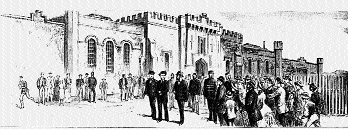
O’Donnell leaving prison for the court house in Port Elizabeth.(Graphic, 6 September 1883)
In Abbey Street, in the heartof Dublin, several large boxes were set ablaze. At Temple Bar, acrossthe river, large fires were lit in the centre of the street and theinhabitants threw old mattresses and broken furniture into them andcheered O’Donnell. An effigy of Carey was burned in Cork, another onewas carried through the streets of Limerick, a mock wake was held inClaremorris, there were noisy demonstrations in Newry in the north andin Queenstown (Cobh) in the south. In Dublin the children were goinground begging passers–by for a penny ‘to burn James Carey’.
Inthe Cape Colony too there was evidence of sympathy for O’Donnell. Asection of the crowd cheered him when he was brought ashore and stoneswere thrown at the sentry outside the gaol. The authorities thought itnecessary to take precautions in case there would be a rescue attempt.
…and official concern
Amongthe ruling class in Britain and Ireland the immediate reaction to themurder was strong criticism of the authorities for failing to protectCarey. Credit was given to Mallon and his men for spiriting Carey outof Ireland but the rest of the operation was roundly condemned. Was itnot the height of folly to send him on the same ship as his wife andseven children, all of whose names were known to the public, as was thefact that she was a notorious tippler? And with no more disguise of hiswell–known features than the shaving off of his beard. The concern wasnot for Carey—it was generally felt that he had got his just deserts—itwas for the effect his murder might have on the flow of information tothe police; would–be informers in future might well be deterred byCarey’s fate.
O’Donnell, the journalist’s Fenian
Thatwas assuming that Carey had been executed by the organisation he hadbetrayed. And everybody did. And many still do. The newspapers at thetime announced that O’Donnell had been sent to kill Carey and accountsof his activist background began to appear. He was believed to havebeen one of the men who attempted to blow up the Mansion House inLondon two or three years before; he had been involved in the Fenianrising at Tallaght in 1867 and afterwards he had escaped to England andhad worked at Preston before emigrating to America; he had gone to SanFrancisco in 1871 as a Fenian agent; he appeared in New York in 1881and took part in a dynamite conspiracy; when Carey was arrestedO’Donnell was sent to Dublin as chief of a group to watch the course ofevents; he was believed to have acted under the direction of PatrickTynan; he had eked out a living selling photographs of Irish Americans;he acted as a sort of agent for public speakers, amongst them MarkTwain. There was not a word of truth in any of this press speculation.
The real O’Donnell
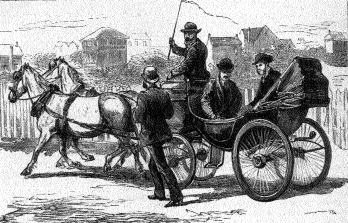
O’Donnell being conveyed to the court house in Port Elizabeth. (Graphic, 1 September 1883)
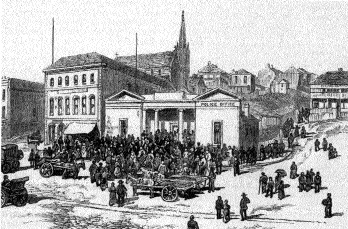
Scene outside the court house in Port Elizabeth. (Graphic, 1 September 1883)
PatrickO’Donnell was born in the Gweedore district of Donegal in 1838. Heemigrated to the United States when he was about sixteen years of age.He worked in Brooklyn and Philadelphia at first, and then in Ohio andToronto, originally in hotels and then for a time as a butler, whichmay explain his bearing which led some journalists to believe that hehad had military training. Later he worked on the gold and silver minesin the western states, Montana, California and Nevada. He was not aFenian. He was never involved in any political activity. When he heardof the diamond discoveries in South Africa he decided to try his luckthere. He left New York on 19 May 1883 to visit his mother and brotherin Donegal before going to South Africa, so he arrived home right inthe middle of all the excitement, for Carey first appeared in court asan informer on 17 February and his friends were hanged between 14 Mayand 9 June. From Donegal he went to Derry and then to Liverpool andLondon. At some point he met a young woman of about eighteen or twentycalled Susan Gallagher, from his home district. He proposed that sheshould accompany him to South Africa as his wife and when a priest inLondon refused to marry them when it emerged that he had a wife inAmerica they nevertheless booked a cabin as a married couple. However,we are assured that, as befitted a national hero in Victorian Ireland,‘the relations of brother and sister alone subsisted between them’. Itwas quite fortuitous that O’Donnell was on the same ship as Carey.
During the voyage O’Donnell had no suspicion about Power’s identity. Itwas only when they got to Cape Town that revelation came. A steward anda passenger called Williams had come to the conclusion that Power wasCarey but they kept the conviction to themselves. Within a day of theKinfauns Castle’s arrival, however, the rumour was circulating in CapeTown that Carey was among the passengers. In Cape Town Carey drewattention to himself by ranting against the English in a pub andprecipitating a brawl. Another passenger from the Kinfauns Castle,Robert Cubitt, got into conversation with a hotel owner who had nodoubt about Power’s true identity and produced a picture of Carey fromthe Weekly Freeman of 5 May. Cubitt recognised the picture and took itto show O’Donnell. O’Donnell said ‘I’ll shoot him’ and asked for thepicture. But Cubitt attached no importance to what O’Donnell saidbecause he spoke pleasantly and displayed no anger or outrage. By thetime the Melrose sailed Carey’s identity was common knowledge in CapeTown. And Carey knew—he asked for the loan of the paper and took it toshow his wife. One of Carey’s children said that as the Melrose castoff people on shore were pointing at his father.
Motivation
How,then, did O’Donnell come to shoot Carey and why did he shoot him whenhe did? The first question is the easier one to answer. As somebody whohad lived in the American west he was in the habit of carrying a gun.Suddenly he had a compelling urge to use it. Nationalists in Ireland,America or anywhere else, whether or not they were politically active,were passionate in their denunciation of Carey. O’Donnell’s recentvisit to his home in Donegal, where feelings ran high, would havereinforced his repugnance. Why he shot Carey on board and not afterthey had landed in Natal when, as both O’Donnell himself and hisbrother pointed out later, there would have been the chance of escape,is an unanswerable question. Perhaps it was an urge to expiate theshame of having consorted with the hated informer, drink–inducedrecklessness, an irrationality which made him incapable of assessingthe consequences of his action, we are reduced to speculation. Perhapsthe Natal Witness’s explanation is as good as any; it speculated thatO’Donnell committed the murder in ‘one of those extraordinary fits ofDon Quixotism which frequently characterises some sections of the Irishpeople’.
The making of a martyr
O’Donnell’smotivation was not an issue of immediate concern to Irish nationalists;their response to his arrest was to rally to his defence. A Fair TrialFund was set up in Ireland and an appeal for support was made toIrishmen living in England; the nationalists of Bradford forwarded£4–10–0 to the fund ‘as a mark of our abhorrence of the defunctmiscreant Carey and all such base informers’. In Cape Town a meetingpresided over by a prominent citizen, J.T. O’Reilly, launched a fundfor O’Donnell’s defence.
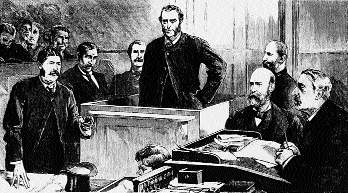
O’Donnell under examination in Port Elizabeth. (Graphic, 6 September 1883)
O’Reilly was at pains tostress that their desire to help a fellow Irishman in a strange countrydid not imply approval of his deed. But among the thirty–strongaudience some were less circumspect. One, O’Neill–Lyster, in thankingthe press for impartial reporting of the O’Donnell affair said thateven the most inveterate Invincible, if such there were in the colony,could not have taken exception. Whereupon the secretary of the fund,Fraser–Cassen, interjected ‘They will come’. Over £30 was raised at themeeting. It was reported that Sir Thomas Upington, a leading advocateand politician at the Cape and a native of Cork, was to representO’Donnell. Disturbed by such pro–O’Donnell sentiment the Britishgovernment put pressure on the Cape government to have O’Donnellreturned to England for trial.
The American response wasenthusiastic. Patrick Ford in New York sponsored a defence fund in hispaper the Irish World and another one was started in Chicago. AnAmerican lawyer, General Pryor, was sent to London to help with thedefence. O’Donnell’s estranged wife in Philadelphia went to England inthe hope of being able to help him but he had been sentenced by thetime she arrived. Thanks to the success of the American defence appealsO’Donnell had the services of two leading barristers, Charles RussellQC, MP for Dundalk, and A.M. Sullivan. In support of an ingeniouscontention that O’Donnell shot Carey in self defence they brought SusanGallagher back from Port Elizabeth with the intention of calling her asa witness, but she proved to be too innocent, or too honest or toostupid to risk in the witness box. A.M. Sullivan wrote a sugary articlein The Nation comparing her with Sir Walter Scott’s heroine in TheHeart of Midlothian, ‘Susan Gallagher, the Irish Jeannie Deans’, tocover up their miscalculation.
The defence effort failed, as itwas bound to; after a two–day trial at the Old Bailey O’Donnell wascondemned to death and hanged at Newgate prison on 17 December 1883.That changed the emphasis to securing O’Donnell’s status as a nationalmartyr. In America fourteen Democratic members of Congress had waitedon President Arthur and urged him to press for a commutation ofsentence. The conviction, said the Chicago Citizen, ended for ever inthe Irish mind all hope of even ordinary justice from Englishmen. Ameeting of some 300 people outside his brother’s pub at Derrybeg a fewdays after the trial made the same point: they looked upon O’Donnell,they said, as the latest martyr of British law. There was also enoughmoney left in the American defence fund to erect a tombstone memorialin Glasnevin cemetery:
In memory of Patrick O’Donnell whoheroically gave his life for Ireland in London, England on 17thDecember 1883. No tears but prayers for the dead who died for Ireland.This memorial was erected by the grateful admirers of his heroism inthe United States of America through the Irish World and forwarded by aladies committee of New York. Mrs Maggie Halvey, Mrs F. Byrne, EllenFord.
A Celtic cross in O’Donnell’s memory was also erected at Derrybeg. The inscription in Irish reads in translation:
Inloving memory of Patrick O’Donnell from the parish of Gweedore who wasput to death in Newgate prison, London on the 17th December 1883 forhis loyalty to Ireland.
O’Donnell was also the subject of aballad, the accolade of a popular hero, unfortunately one weak in bothliterary merit and historical accuracy:
I sailed on board the ship Montrose (sic) in August ‘83
Before I landed in Cape Town it came well known to me
When I saw he was James Carey we had angry words and blows
The villain he tried to take my life aboard the ship Montrose.
The Carey–O’Donnell drama keeps cropping up in unexpected places.Within the last few years it has appeared in such diverse sources as anIrish thriller, the Oxford Companion to Irish History, a glossy historyof a shipping line and an Irish almanac and yearbook of facts. All ofthem, like the ballad, have garbled versions of the story.
J.L. McCracken is professor emeritus of the University of Ulster.
Further reading:
J.L.McCracken, ‘The death of the informer James Carey: a Fenian revengekilling?’ in D.P. McCracken (ed), Southern African–Irish Studies, 3,1996.
N. Ó Donaill, ‘Dálach Ghaoth Dobhair’, in Donegal Annual, 1960.
V. O’Donnell, ‘Pat O’Donnell’, in Ó Domhnaill Abú, 17, 1991.
















